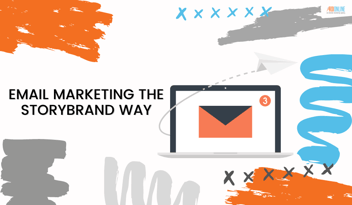Here's Why Your Email Nurturing Campaign Is Failing
Here’s a common scenario: You’ve written an email nurturing campaign promoting your business’s product or service and sent it out to your list.
However, your unsubscribe rates are higher than the click-through rates. We don’t even have to talk about how you haven’t made a single sale.
So what did you do wrong?
You made your business, product or service the main focus of your emails. You talked about how amazing your solution is and how your grandfather started the business 50 years ago. You think you’re swooping in to save the day with your awesome product.
But here’s the problem. You’ve positioned your company as the hero of this story rather than the customer. I hate to be a Debbie Downer, but no one really cares about how your grandfather started the company with $5 in his pocket, how you’ve won Best of [Insert Your City's Name Here] 10 years running or why your product is the bee's knees.
We’re a self-centered race. We only care about OUR story. All we want to know is how your business can help us achieve our goals and solve our problems.
In order to clinch those sales, you must truly understand your customer’s story. Ask yourself,
- What problems are they experiencing?
- What are their doubts and fears?
- Who are they and who do they want to become?
By creating buyer personas of your ideal audience, you can hone in on your customer's’ problems, needs and goals.
Download our FREE Buyer Persona eBook and learn how to understand your customers’ stories!
People desire to be understood. They desire a connection. And, according to StoryBrand, they want to be the heroes of their own stories. You’re simply the guide.
Interested in learning more about StoryBrand? Sign up for their online course.
9 Tips For Sending Better Emails
Here are nine simple tips for creating a successful email campaign.
1. Put The Customer First
To make your brand resonate with people, your emails need to be customer-centric. Position your customer as the hero and your brand as the trustworthy guide.
For example, in this email we created for marketing professionals, we made the customer the hero, quite literally, of the email.
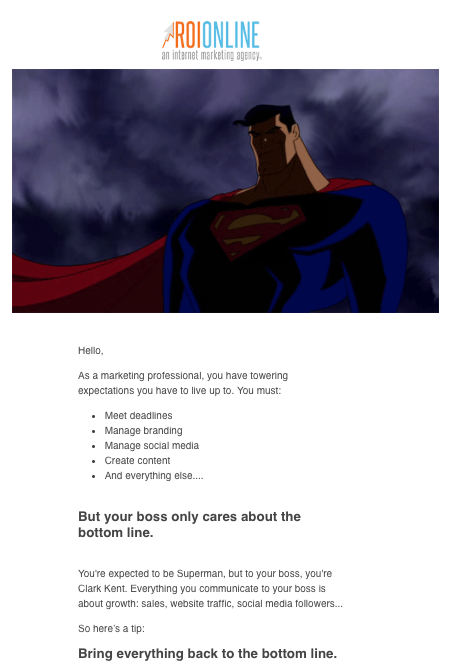
2. Speak To The Customer
Don’t talk about business. Remember, you are sending this email to someone else, not yourself. Your emails should speak to the customer by using “you” and “your” rather than “we,” “I” and “my.”
This email from Ethan Allen is the perfect example. In bold letters, they say, “designer picks FOR YOU.” They put emphasis on the recipient and styles they think “you will love.”
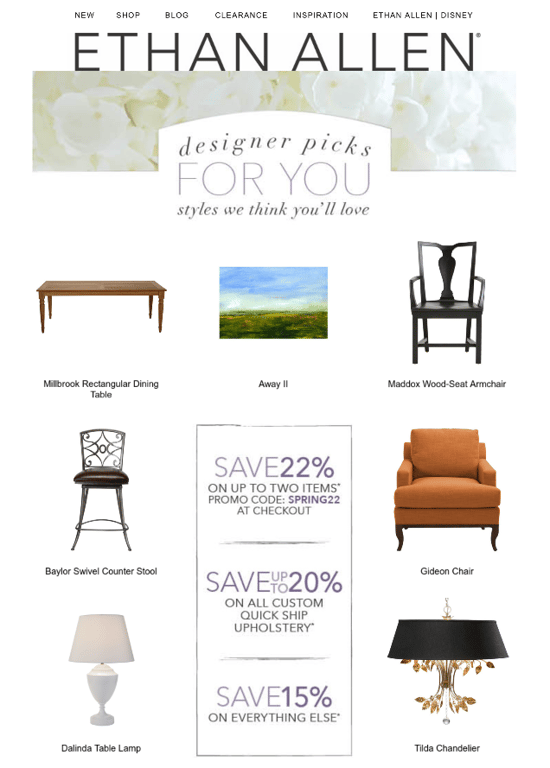
3. Write A Click-Worthy Subject Line
What are you more likely to click on in the sea of unopened emails in your inbox? An email with the subject line, Here’s Our Summer Fitness Newsletter, or The Secret To Not Gaining Weight This Summer?
Entice recipients to open your email by teasing the content of the email and showing them a glimpse of what’s in it for them if they do open it.
MapMyWalk immediately opened a story loop in my mind with their subject line. Of course I want to know how to burn more calories while walking. Plus, they gave their subject line extra pizazz with that fiery emoji. Warning: use emoji in subject lines with caution; only use when appropriate.
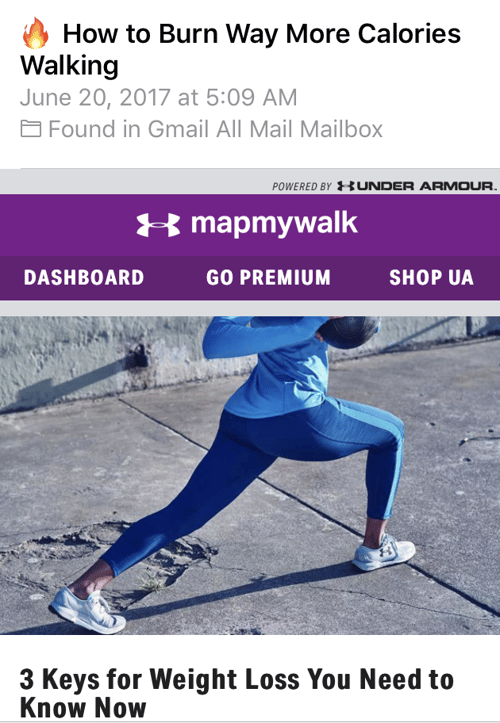
4. Make It Visual
You know how I mentioned we are a self-centered race. Well, we’re also busy. We are blasted with 3,000 commercial messages a day so we really only have time to scan content.
We want to know what’s in it for us as soon as we open the email. That’s why eye-catching imagery and interactive graphics are vital.
Boxed does an excellent job of incorporating strong imagery and making their email super scannable. Right off the bat, I can easily see the benefits of using Boxed. Additionally, they use an aspirational photo of a happy couple unpacking their package. Please feel free to use the coupon code.
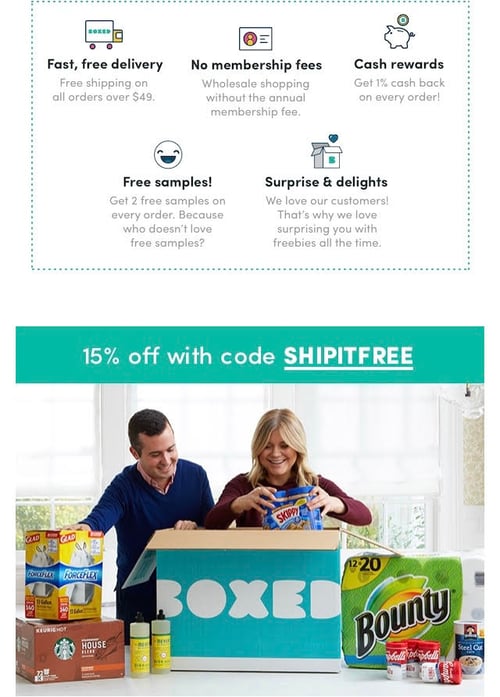
5. Offer Value
Give the recipient something to make opening your email worthwhile. You could offer them a coupon or free trial, for example. You can also provide an irresistible lead-generating PDF that addresses their problem, such as a free checklist, guide or whitepaper with a solution. An offer can even be as simple as free advice.
This email for one of our clients not only opens a story loop in the recipient’s mind about the quality of their drinking water, but it also offers a free comparison chart so they can discover what’s really in their water.
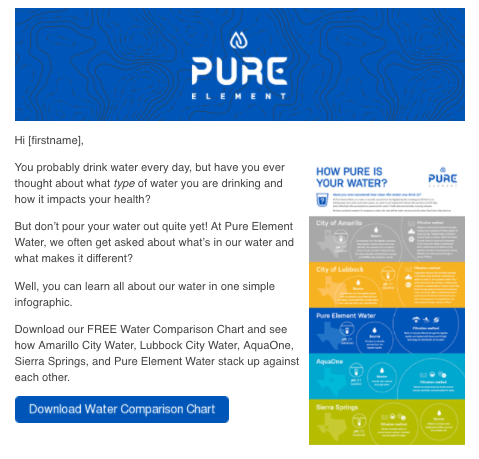
6. Address A Problem
What are your customers experiencing? Remember how we mentioned buyer personas above? Once you understand your customers’ problems or desires, you can show how your product or service can solve or fulfill them.
StoryBrand does an amazing job of addressing their target audience’s problems in their emails. This email immediately spoke to me 1) because the subject line was catchy, asking “do you hate meetings?”, 2) it spoke to a problem, and 3) it offered a solution.
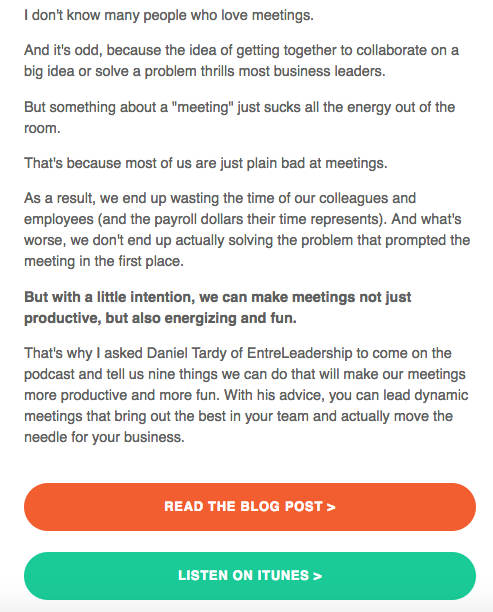
7. Show Success
What benefits can someone experience if they purchase your product or service? Simply show them the “after.” You can do this by providing a bulleted list of benefits or through imagery, for example.
Let’s take a look at this Casper email. Casper is throwing the mattress world and industry leaders like Serta and Sealy for a loop. This image literally shows success (a relaxed, happy couple in a comfortable bed) and text that tells you what your life (the best life) will be like after you purchase their product.
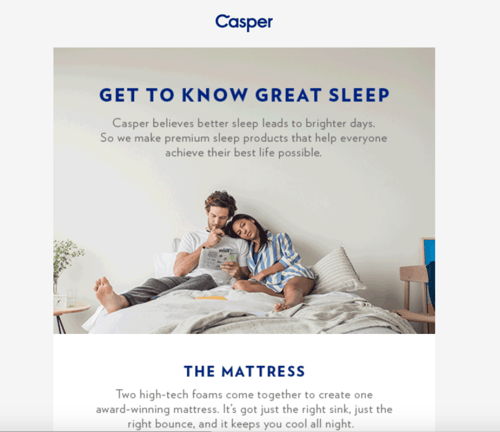
8. Tell Them How To Act
A key element to a successful sales email includes a plan for the recipient to take. Whether it’s to buy your product, download a free white paper or get a discount code, you must provide them with steps to engage with your brand.
Master copywriter, Ray Edwards, doesn’t miss a beat when it comes to including calls-to-actions in his emails. Remember, people scan emails so you want to give them plenty of opportunities to click those CTAs.
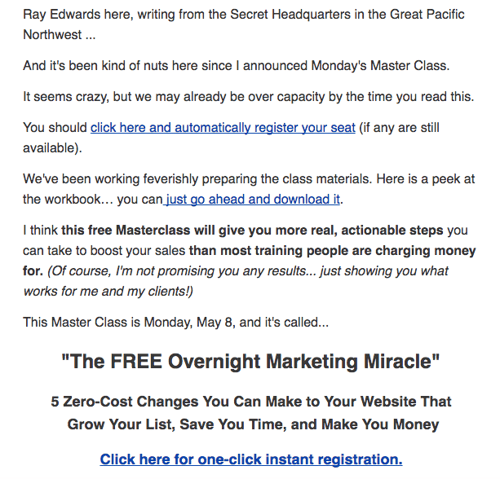
9. Include Testimonials
Give recipients proof that your product helps people win and makes their life better. You can do this by including a customer testimonial, such as a quote or video clip.
You can also use reviews of your product and even social media posts from satisfied customers. According to a 2016 online review survey, 84% of people trust online reviews as much as a personal recommendation.
This Bobbi Brown email includes a number of customer reviews showing successful results and transformations. What makes it even more powerful is that they include links below each product so people can quickly make a purchase.

So what’s the moral of this story?
- Make your customer the hero,
- Provide them with a plan,
- And show them how your product or service can make their life better.
Want to see how StoryBrand can transform your business's marketing? Schedule a free strategy session with us to learn more about StoryBrand!
Photo by Glenn Carstens-Peters on Unsplash




